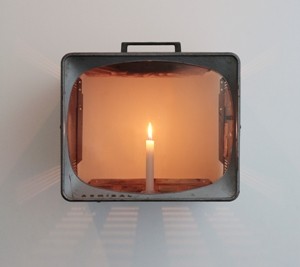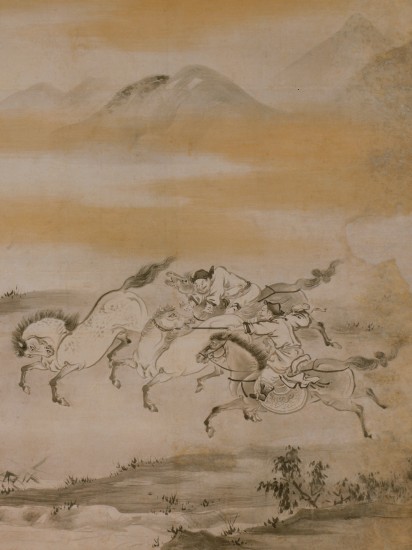Selections from the Hara Museum Collection: Materials and Motifs—The Things They Tell Us
June 30 |Saturday| – September 9 |Sunday|, 2012
Hara Museum ARC Galleries A, B and C

Nam June Paik, Candle TV, 1980
Needless to say, we in modern society are surrounded daily by countless things. These are things made by us and things that existed way before. We live our lives using, looking at and reacting to these things. This summer, Hara Museum ARC takes a look at materials and motifs, two “things” that give artworks their form and their meaning, respectively. With their superb sensibilities and inquiring minds, artists engage and interact with materials and motifs, to sublimate and transform them into artistic expressions.
If something that you should know well speaks to you looking totally different, don’t feel flustered. Because in that conversation, you get to say the next word.
Featured artists
Koji Enokura/Toshikatsu Endo/Shinro Ohtake/Yayoi Kusama/Ushio Shinohara/Tabaimo/Kosai Hori/Yukinori Yanagi/Katsuro Yoshida/Lee UFan/Karel Appel/Arman/Armando/Christian Boltanski/Jasper Johns/Anselm Kiefer/Nam June Paik/Louise Nevelson/Jean-Pierre Raynaud and others
Selections from the Hara Rokuro Collection: The Beauty of Sumi Ink
June 30 |Saturday| – August 1 |Wednesday|, 2012
Hara Museum ARC Kankai Pavilion

Kano school, Wild horses and horsemen, detail, Momoyama – Edo period
The chiaroscuro produced by sumi ink in an ink painting gives it a depth of a different character from the colors in an oil painting. With the ink, we have richly expressive lines and bleed effects and the different impressions that are triggered by its tonal quality. Taking in each brush stroke with careful scrutiny, enjoying the infinite variety of images and color schemes—these are just some of the pleasures that ink paintings provide us. The rich and varied beauty of sumi ink are on full display in these selections from the Kano school of Japanese painting.
Featured works (selected)
Traditional Art
Kano school, Scene based on an anecdote by Tao Yuanming (poet of Jin dynasty) (part of paintings used for wallpaper and sliding doors at Nikko-in guest hall in Mi’idera temple), four hanging scrolls, Momoyama period/Kano school, Wild horses and horsemen (part of paintings used for wallpaper and sliding doors at Nikko-in guest hall in Mi’idera temple), four hanging scrolls, Momoyama – Edo period/Kano Takanobu , Huangshi-gong and Zhanglian under a pine tree (part of a set of twelve hanging scrolls by painters of the Kano school), hanging scroll, Edo period, and others
Contemporary Art
Yves Klein, Blue Sponge, 1960/Toshimitsu ImaÏ, Water, 1977/Hiroshi Sugimoto, Seascapes, 1988-1991/Anish Kapoor, Void, 1992/Noe Aoki, Tateyama, 2007, and others
Place: Hara Museum ARC (2855-1, Kanai, Shibukawa-shi, Gunma 377-0027)
Tel: 0279-24-6585
Organized by: Hara Museum of Contemporary Art
Hours: 9:30 am – 4:30 pm *Last entry 30 minutes before closing
Closed: Thursdays (except during the month of August)
*Closed temporarily in the event of severe weather.
Admission: General (over 12) 1,000 yen; Children (over 3) 500 yen; 10%
discount for a group of 20 or more.
**Children must be accompanied by an adult
***Combination ticket for Hara Museum ARC and Ikaho Green Bokujo ranch: General 1,800 yen; Children 900 yen
Hara Museum ARC is now participating in MuPon (museum discount ticket system
using iPhone application)!
Getting There
By train: Take the Joetsu Shinkansen to Takasaki, change to
the Joestu Line, and disembark at Shibukawa. From Shibukawa, ARC is 10
minutes away by taxi or 15 minutes by bus (take the Ikaho Onsen bus to ″
Green Bokujo Mae″). By car: 8 kilometers (about 15 minutes) from the
Kan-etsu Expressway Shibukawa Ikaho Interchange (in the direction of Ikaho
Onsen).
By Train
◇By JR Joetsu・Nagano Shinkansen
Recommended timetable
・8:04 Depart Tokyo Station→9:05Arrive at Takasaki Station/ 9:17 Depart
Takasaki Station→9:42Arrive at Shibukawa Station
・11:44 Depart Tokyo Station→12:33Arrive at Takasaki Station/ 12:50 Depart
Takasaki Station→13:14 Arrive at Shibukawa Station
・12:24 Depart Tokyo Station→13:14 Arrive at Takasaki Station/ 13:31 Depart
Takasaki Station→13:58Arrive at Shibukawa Station
◇By JR Joetsu Limited Express Kusatsu
・9:00 Depart Ueno Station→10:39Arrive at Shibukawa Station
(No.3; operates only on Saturdays, Sundays and holidays)
・10:00 Depart Ueno Station→11:44 Arrive at Shibukawa Station (No.1)
・12:00 Depart Ueno Station→13:42 Arrive at Shibukawa Station (No. 3)
From Shibukawa Station, take the Kan-etsu Kotsu Bus and get off at the
station “Green Bokujo Mae.”
http://www.kan-etsu.net/r-bus/timetable/shibu-ikaho-1.htm (in Japanese
only). ARC is about 7 minute walk from the bus station.
By Car
Take the Kan-etsu Expressway to Shibukawa Ikaho Interchange. Go in the
direction of Ikaho Onsen for 8 km (about 15 min.) .
Highway information:
E-NEXCO Drive Plaza http://www.driveplaza.com/ (in Japanese only)
Express Bus (Shinjuku-Ikaho)
Jyosyu Yumeguri Go
Persons who use Shinjuku or Nerima stations will find this express bus very convenient.
http://www.haramuseum.or.jp (museum website)
http://mobile.haramuseum.or.jp (mobile site)
Follow the Hara Museum and Hara Museum ARC on Twitter and get the latest news:
http://twitter.com/HaraMuseumARC(@HaraMuseumARC)
http://twitter.com/haramuseum (@haramuseum)
